It's time once again to talk about some more weird cards. 4 weeks ago was when I talked about some weird cards in Magic: The Gathering, and since this is a really fun topic to talk about, I'm here with 7 more cards from the game to talk about because they have some bizarre quality about that separates them from the rest of the game.
This article is going to have some more modern cards than the previous article which was almost entirely very old cards from the game's infancy, although a few of those will be here as well because you can't escape that time period when you make an article/video/whatever about this topic. But even in the more modern days, you can see how the card design team sometimes goes way out there, and it's always fun to break the boundaries of the game to see what exactly you can get away with. As someone active in the custom Hearthstone scene, this is just the norm for me.
Raging River
Raging River is one of the most flavorful, immersive, and downright insane cards in the history of the game. It's also an absolute classic in terms of cards to bring up whenever the target of cards whenever the topic of this article comes up.
The card is a bit clunkily worded, but in essence, it basically splits each player's creatures into two sides of the battlefield (or the "river"). When you attack, both players decide what side of the battlefield their creatures go to, and any creatures on one side of the battlefield cannot block or be blocked by creatures on the other (represented by the fact that they're on opposite sides of the river). Flying creatures are not affected by this and can block whatever side they need to at the time (since they can obviously just fly over the river). If you've ever played Elder Scrolls: Legends, then here's a way to play Elder Scrolls: Legends in Magic: The Gathering, even if it doesn't work quite the same way.
Raging River remains as a card that stands out because there's arguably no other card in the game that immerses the terrain onto the battlefield like this one (though your mileage may very on that front). Not surprisingly, the card hasn't been reprinted since 1993 (the very first set of Magic's existence), although there was a Mystery Booster card printed in 2019 called Problematic Volcano which effectively serves as an homage to this card, and according to Ethan Fleischer, a mechanic that worked in a similar vein was experimented with for Theros: Beyond Death in 2020. What a crazy would that would be.
Steamflogger Boss
Steamflogger Boss is another staple card that appears in discussions of cards in the game with very unusual abilities. The card was first printed in Future Sight in 2007 as the third expansion in the Time Spiral block. One aspect of this set was this awful card frame design that I'm very glad they don't use, but another one was the use of "Timeshifted" cards, which in this case was supposed to show off what a potential future of Magic would look like. The card frame design was one way of representing this, but another was through card mechanics that weren't utilized by the game yet.
This is precisely where Steamflogger Boss comes in and why it has remained such a noteworthy card for the entirety of its existence. Steamflogger Boss has two abilities. The first is that it gives your other Rigger creatures +1/+0 and haste, and the second is the more infamous ability of doubling up on assembling Contraptions whenever one of your Rigger creatures assembles one. A player extremely new to Magic might look at this card and wonder why its weird, and they would be in for quite the surprise when they find out.
If you aren't familiar with Magic (which is entirely reasonable given that we cover multiple card games on the site and there will be readers that don't particular about some of the games we cover), then the big deal with this card is the fact for 10 years, the ability simply couldn't be utilized under any circumstance at all. While a Changeling creature could potentially count as a Rigger, there were no natural Rigger creatures, nor any way to assemble Contraptions until 2017.
The card was originally made as a joke, but because the card was so notable by everybody, the team over at WotC had finally figured out a way to implement Riggers and assembling Contraptions into the game in the Unstable set. Steamflogger Boss itself would later be reprinted in the set as well (with the normal card frame design). Even though I don't normally allow silver-border cards into these articles, the card was originally printed in a black-border set, and thus I think it's fair game. The card has also just cemented its place into the hearts and legacy of MTG players that much that of course I would have to talk about it.
One With Nothing
Never before has a card with such a short ability bewildered the minds of so many players as one of the most infamous card in the game, One with Nothing. Sometimes thought of as one of the worst cards in the entire game, One With Nothing has firmly taken its place among the game's history. Not just because it's a terrible card, but also because it's been desperately trying to cling on to a valid strategy ever since it was printed in 2005, and players have been trying to find that strategy for basically the entire time it has existed.
The way to use this card is quite obvious. It puts your whole hand in your graveyard, which of course is useful for decks that want things there, and interacting with your graveyard is something that black naturally does quite well. Discarding your hand for benefit is one of the most staple designs of any card game, and One With Nothing is a card that puts that to the absolute biggest extreme that it can. However the benefit here is not so direct.
While other cards that discard your cards give you some immediate benefit on its own like summoning creatures, drawing cards, or also force your opponent to discard cards as well, One With Nothing has no direct benefit by itself and you need other cards to make use of it. Discarding your entire hand also means that you will inevitably have to discard cards that you don't necessarily want to discard as opposed to other cards which simply let you pick and choose. The upside to that though is simply the sheer number of cards you send to your graveyard right away at Sorcery speed for only 1 mana.
So while the card is always in the minds of Magic players for being very unplayable, it's also always in another part of their minds that the card may become playable one day. The groundwork for something that can be utilized with it in theory already exists, and all it needs is the perfect piece of architecture to finally complete it. It's like realizing that you only need one weirdly-shaped Lego block left to complete your absolutely massive build and relentless scouring everywhere you can to finally get hold of it and finish that build. One day, players may find that block and One With Nothing becomes a staple part of a new combo. It's even entirely possible that the block already exists and nobody is aware of it yet. Until then, One With Nothing is a card that no one will use, but will continue its multi-decade journey to find greater purpose and we can all learn something from its perseverance.
Mana Crypt
Mana Crypt is a card with a very interesting story behind it. The card itself isn't that really what gets the card in this article as much as it is the aforementioned story. Something about the card that is rather bizarre though is the fact that in its original printing, your opponent calls the call flip whereas in most other printings, you call the coin flip. The tale that this card has to tell however is quite a read.
From 1994 to 1995, the short lived publishing studio HarperPrism published 5 promotional Magic: The Gathering books. Each of these books allowed you to exchange a promotional voucher for a card. Mana Crypt was one of those cards, along with Arena, Sewers of Estark, Windseeker Centaur, and Giant Badger. As you can imagine, being forced to buy books to get one card did not sit well with everyone, resulting in the series stopping after 5 books and this particular methodology of implementing promotional cards wouldn't be used again.
Of the 5 cards, Mana Crypt was by far the most interest to people who wanted to hunt these cards down. Arena and Giant Badger would both be reprinted in Time Spiral and 8th Edition respectively, but other 3 had not received any reprints, meaning that the only way to achieve them was to either buy the right book and exchange the voucher and wait for your card to be delivered to your address, or hunt it down from a seller. Given that the promotion was already well over at this point, the latter was the only real option that you had for an incredibly long period of time.
After 16 years, the card was reprinted in 2011 as a DCI Judge Promo, but the card would of course still remain incredibly rare and hard to come by. In 2016, 21 years after the card's original printing, Mana Crypt finally received some type of accessible release in the Eternal Master reprint set. The set had a limited print run and printed the card as a Mythic Rare, so it was still by no means the easiest card in the world to obtain, but it still made the card astronomically easier to acquire than it ever had been before.
Funnily enough, Sewers of Estark and Windseeker Centaur have still not received any reprints, and yet significantly fewer people seem to care about those two cards.
Renowned Weaponsmith
Renowned Weaponsmith is a card that looks entirely normal, but the reason that the card make it into this article is because of the context of its original printing and a few other cards. The card was first printed in Fate Reforged in January 2015. It can tap itself to add 2 colorless mana, but that mana can only be used for either playing artifacts or using the abilities of them. Its other effect is to tap itself and pay 1 blue mana to grab either a Heart-Piercer Bow or a Vial of Dragonfire from your deck. At this point, some of you might be a bit confused as to why this card on the article. So what exactly is the deal with this card?
That would be the cards it searches. While Heart-Piercer Bow was also printed in Fate Reforged at the same time as Renowned Weaponsmith itself, there was no such card in the game called Vial of Dragonfire. The card simply did not exist. So you can probably imagine how bewildering it must've been to open this card, and try to find out what Vile of Dragonfire was only to be completely lost because you would never find it anywhere.
Vile of Dragonfire was printed in the very next set, Dragons of Tarkir, in March 2015. So this confusion would only last for 2 months, but during that time, anyone could've easily found themselves on an arduous journey of inevitable futility that was trying to find a Vial of Dragonfire and falling into a spiral out of being unable to claim the non-existent piece of cardboard. This isn't like Steamflogger Boss where it featured a mechanic that didn't exist as a joke that was never originally intended to be printed. This was a genuine black-border card that was to search two other genuine black-border cards, but one of those cards was just simply not a thing. As for Vile of Dragonfire, maybe it really was part of some crazy conspiracy. Who can really say for sure?
Camouflage
Camouflage is a card that has pretty good flavor and tries to implement that into gameplay, but unfortunately it may just end up bending the basic fundamentals of the game a little bit too much for its own good.
Basically the way it works, as is printed on the card, is that you can cast it when you declare your attackers, turn your attacking creatures face-down and then shuffle them around. Your opponent can choose to block with their creatures as normal if they choose to, but the attacking creatures that it's blocking is only revealed after blockers are fully accounted for. If this results in an illegal block (the example the card gives is a non-flying creature blocking a flying creature), then that block doesn't count.
If you remember Magical Hats from my previous Weirdest Yu-Gi-Oh cards article from 2 weeks ago, you may recognize the mechanics and general idea as being similar to that card by hiding creatures, moving them around, and attempting to catch your opponent off-guard. There aren't actually any rulings about how the player must perform the shuffle, meaning that they could theoretically conceal their shuffling completely and turn your opponent's blocking into a complete guessing game as opposed to trying to follow the shuffle around which might have been the intention of the card. All of this is sort of a moot point though, as the actual card text on the card isn't what you're supposed to use.
Instead, we're going to have to pull up the Oracle Text of the card found on the Gatherer. If you don't know what Oracle Text is, it's basically what is considered to be the official text of the card in the modern day of the game. For the sake of sanctioned play, players are meant to refer to the card's Oracle Text as opposed to what's physically written on the card. This serves a useful purpose as it allows old versions of legal cards with obsolete wordings to be usable without causing issues. It can also serve to clarify how some cards with unique and confusing wordings function. For the most part, this works well, but it sometimes goes a little bit off the rails, and Camouflage is a pretty good example of how extreme that can go.
Cast this spell only during your declare attackers step.
This turn, instead of declaring blockers, each defending player chooses any number of creatures they control and divides them into a number of piles equal to the number of attacking creatures for whom that player is the defending player. Creatures those players control that can block additional creatures may likewise be put into additional piles. Assign each pile to a different one of those attacking creatures at random. Each creature in a pile that can block the creature that pile is assigned to does so. (Piles can be empty.)
Read the original card text, and read the Oracle Text, and feel free to repeat as many times as you need. We'll all understand perfectly if you do. If it doesn't seem like it's even the same card anymore, that's because it isn't. They basically just made an entirely different card. I'm not going to bother trying to pick out how they completely remade the card because I'd basically be writing one entry that's as large as this entire article if I tried that. I basically proved my point. We've only got one more card to go, so let's move on.
Void Winnower
Void Winnower is our final card of this article, and it's no less odd than the other cards in this article (other than Raging River and Steamflogger Boss, but that's not the point). It stops your opponent from playing spells with even CMCs, and if they control any creatures with even CMCs, then they can't block (and your opponent wouldn't be able to play any more of them anyway). Fittingly, its CMC, power, and toughness are all odd numbers.
I want you to tell me right now if when building your deck, the ratio of even-Cost cards versus odd-Cost cards is ever something you've considered outside of Gyruda, Doom of Depths or Obosh, the Preypiercer, of which Void Winnower predates both of these cards by 5 years. Are you maybe playing Ashling's Prerogative? The card notably doesn't affect you, so you're free to play all the even-CMC cards you want with it.
Where does the idea of this specific type of counterplay come from? I don't even know, but if you're playing against a Gyrdua deck and you get this onto the board, then I think you're in a pretty good spot. Just sayin'.


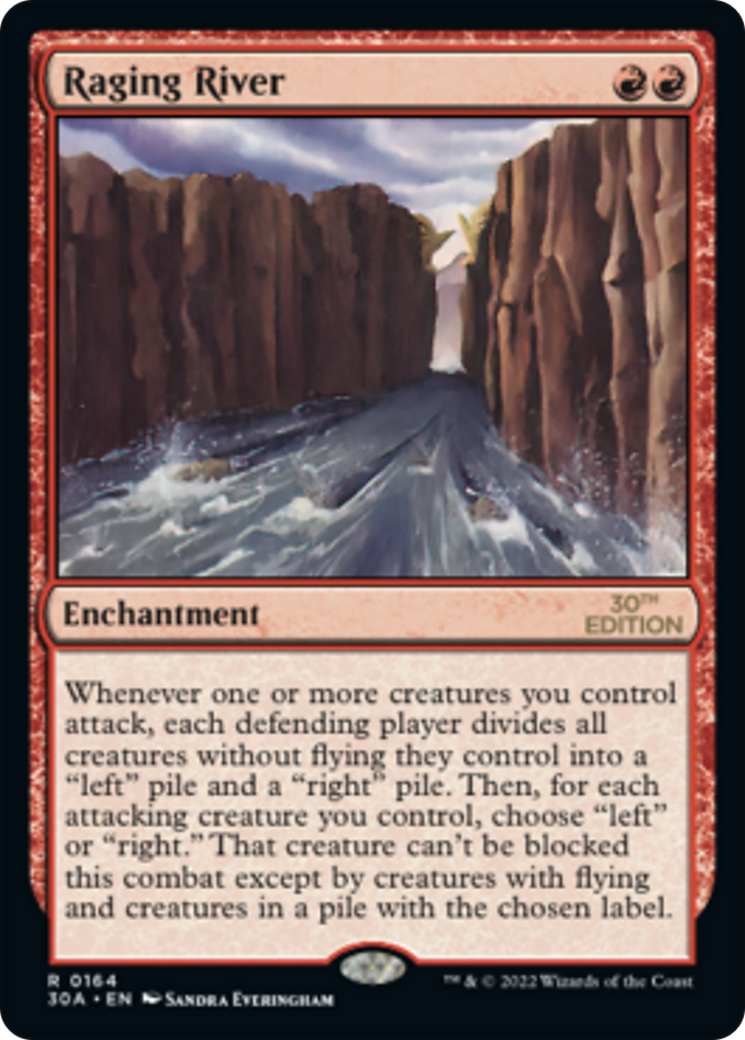
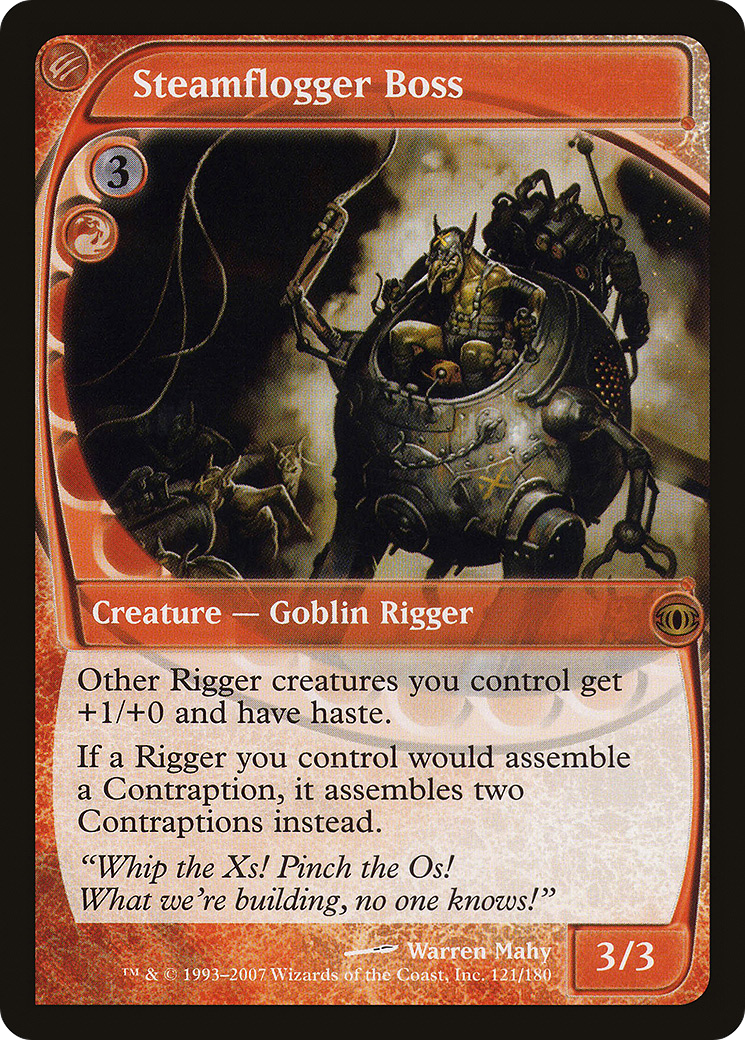
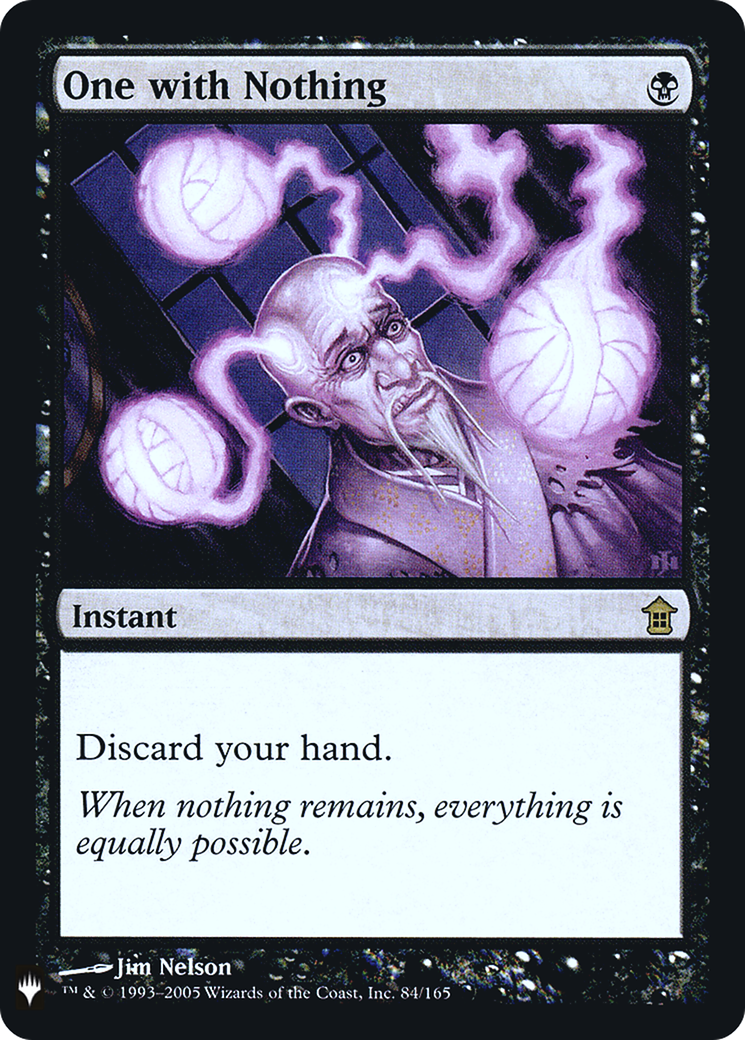
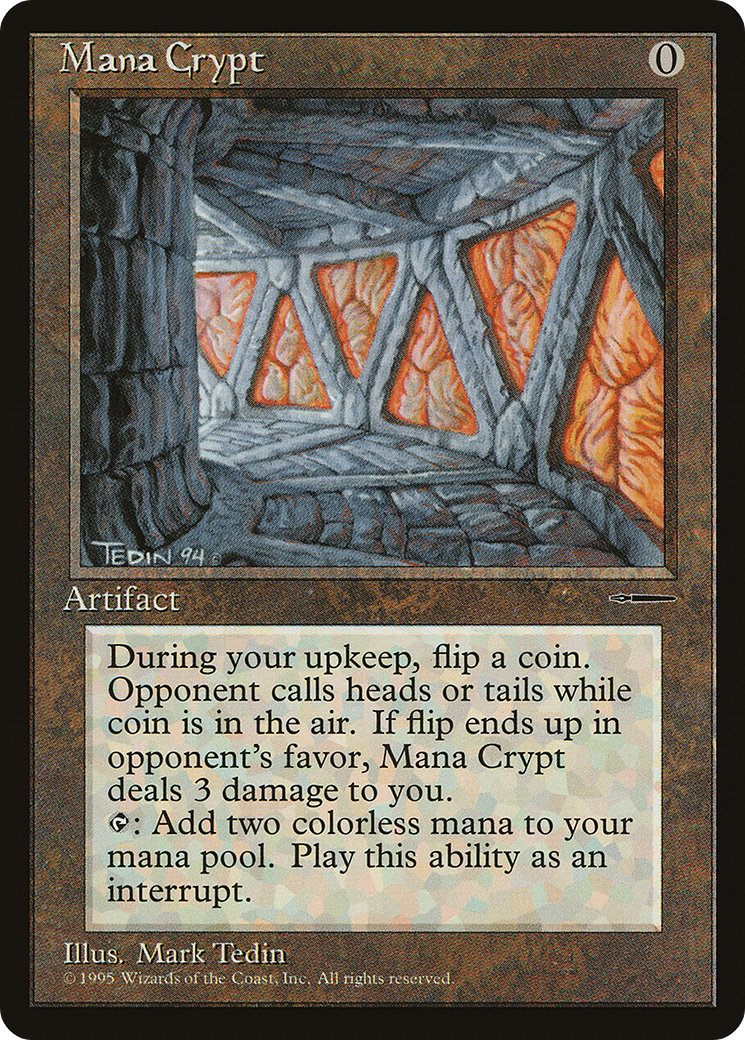
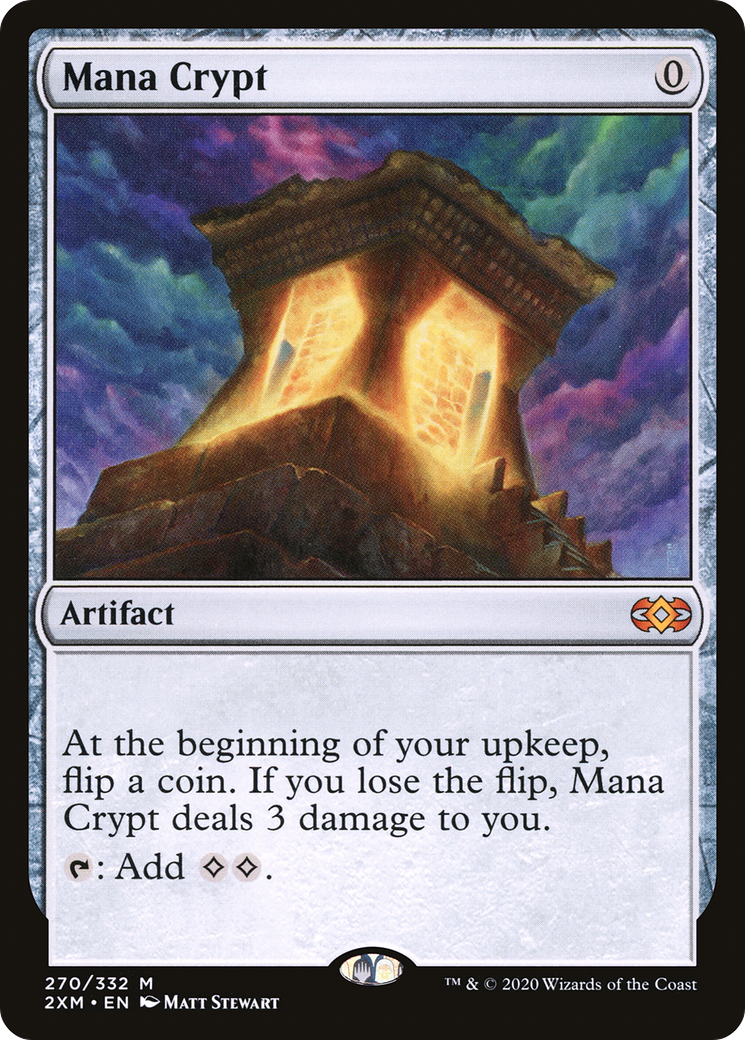
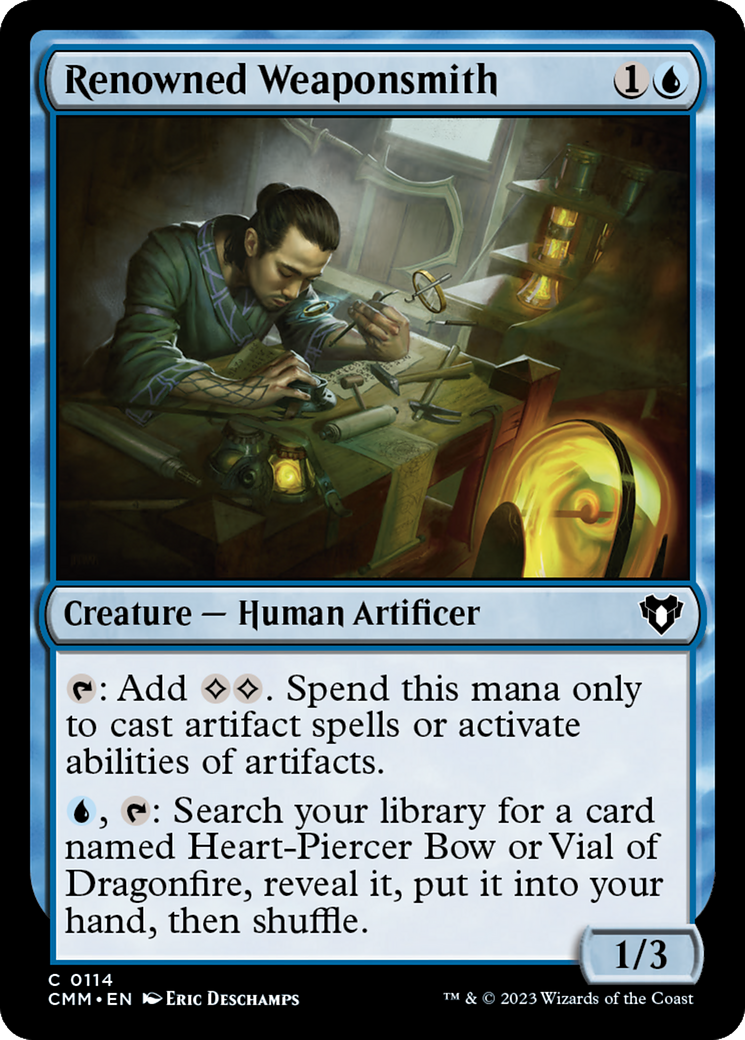
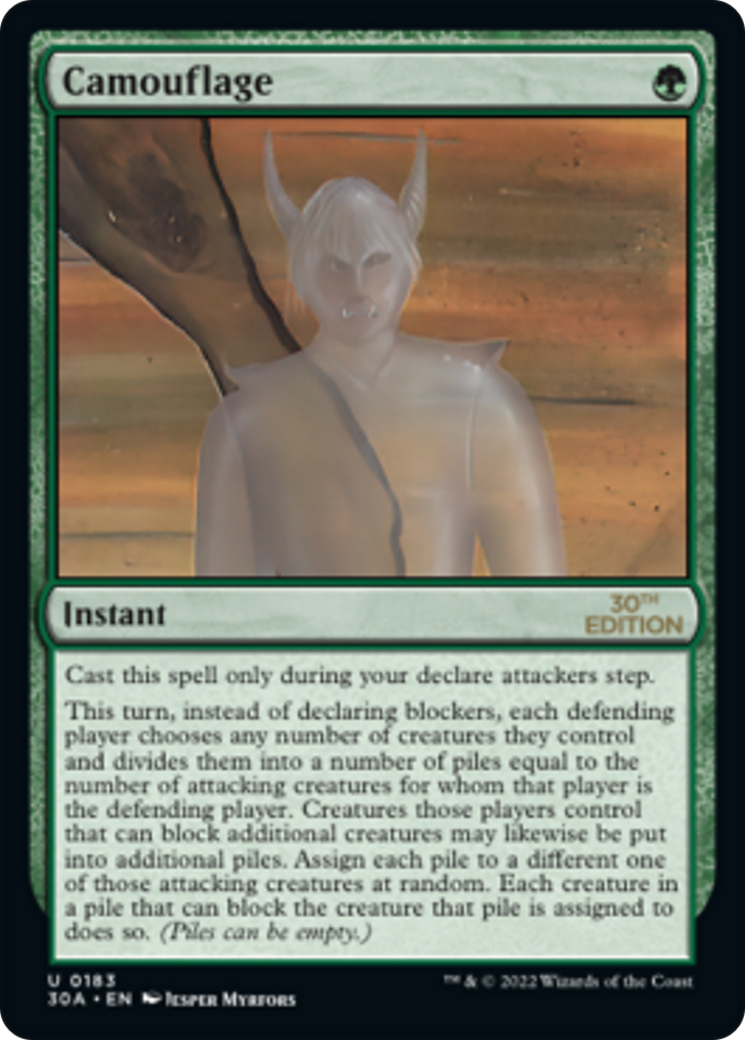
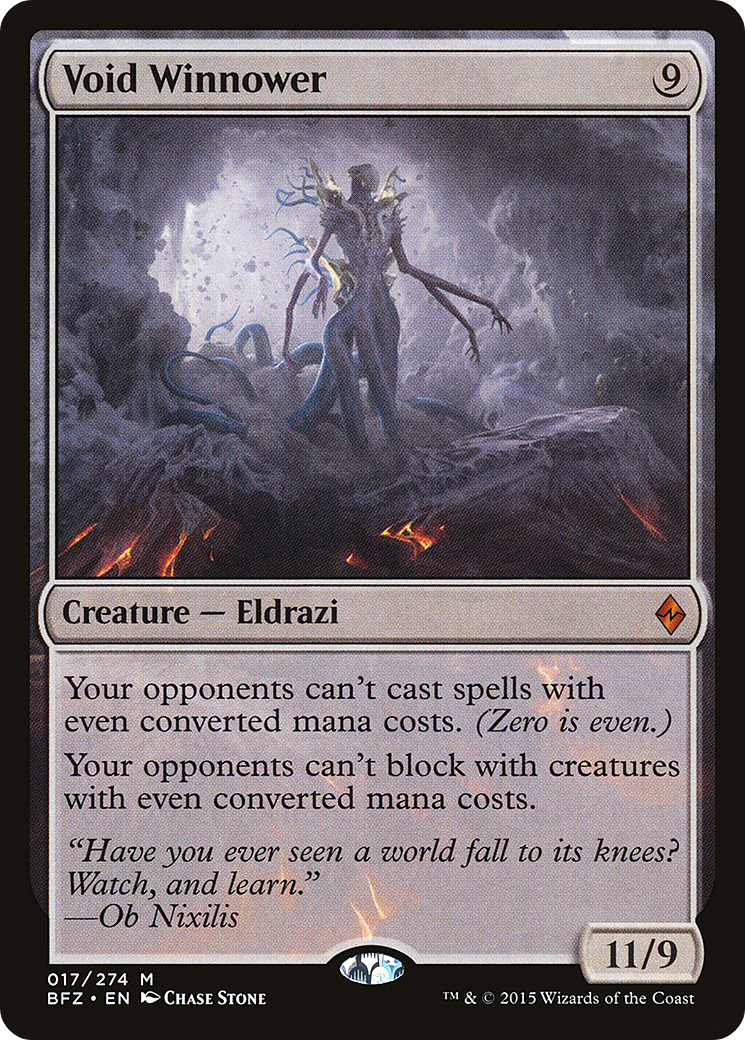



Comments
Great article. Love these weird cards. I had not seen the reprint of Mana Crypt, love that art.
One with Nothing is the type of weird card I love. Just trying to get it to work can be so fun. The look on your opponents face when you play it though is so worth it.